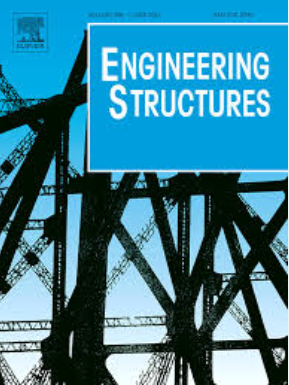Self-adjusting configuration control method for diagonal cable truss structures using deep learning technology
IF 6.4
1区 工程技术
Q1 ENGINEERING, CIVIL
引用次数: 0
Abstract
Cable truss structures are composed of edge cables and internal connection members. A common design involves internal members arranged in a continuous oblique pattern, which is efficiently employed in long-span space structures. This configuration primarily governs the equilibrium of free nodes through the curve of the edge cables. However, manually adjusting the prestress to align with the edge cable shape is challenging due to the variable skew angles of the internal members. To address this, this paper proposes a deep learn method to establish a mapping relationship among the edge cable curve, the coordinates of the free nodes, and the prestress distribution. The force density distribution is automatically adjusted by comparing the coordinates of the free nodes with the edge cable shape. Based on the curve characteristics of the edge cable, the polynomial power function is fitted using the least squares method. A deep neural network model with four hidden layers and Adam optimizer, using constrained node coordinates as input and force density distribution as output, successfully achieved the rational configuration of several typical diagonal cable truss structures. The edge cable shape of each cable truss can be controlled by automatically adjusting its configuration. This method is suitable for cable trusses with complex space topology and achieves a high degree of automation.
基于深度学习技术的斜拉索桁架结构自调整构型控制方法
索桁架结构由边缘索和内部连接构件组成。一种常见的设计是将内部构件布置成连续的斜交模式,有效地应用于大跨度空间结构中。这种配置主要是通过边缘电缆的曲线来控制自由节点的平衡。然而,由于内部构件的可变斜角,手动调整预应力以使其与边缘电缆形状对齐是具有挑战性的。为了解决这个问题,本文提出了一种深度学习方法来建立边索曲线、自由节点坐标和预应力分布之间的映射关系。通过比较自由节点的坐标与边缘电缆形状,自动调整力密度分布。根据边缆的曲线特性,采用最小二乘法拟合多项式幂函数。采用四隐层深度神经网络模型和Adam优化器,以约束节点坐标为输入,力密度分布为输出,成功实现了几种典型斜拉索桁架结构的合理配置。每个索桁架的边缘索形可以通过自动调整其配置来控制。该方法适用于空间拓扑复杂的索桁架,自动化程度高。
本文章由计算机程序翻译,如有差异,请以英文原文为准。
求助全文
约1分钟内获得全文
求助全文
来源期刊

Engineering Structures
工程技术-工程:土木
CiteScore
10.20
自引率
14.50%
发文量
1385
审稿时长
67 days
期刊介绍:
Engineering Structures provides a forum for a broad blend of scientific and technical papers to reflect the evolving needs of the structural engineering and structural mechanics communities. Particularly welcome are contributions dealing with applications of structural engineering and mechanics principles in all areas of technology. The journal aspires to a broad and integrated coverage of the effects of dynamic loadings and of the modelling techniques whereby the structural response to these loadings may be computed.
The scope of Engineering Structures encompasses, but is not restricted to, the following areas: infrastructure engineering; earthquake engineering; structure-fluid-soil interaction; wind engineering; fire engineering; blast engineering; structural reliability/stability; life assessment/integrity; structural health monitoring; multi-hazard engineering; structural dynamics; optimization; expert systems; experimental modelling; performance-based design; multiscale analysis; value engineering.
Topics of interest include: tall buildings; innovative structures; environmentally responsive structures; bridges; stadiums; commercial and public buildings; transmission towers; television and telecommunication masts; foldable structures; cooling towers; plates and shells; suspension structures; protective structures; smart structures; nuclear reactors; dams; pressure vessels; pipelines; tunnels.
Engineering Structures also publishes review articles, short communications and discussions, book reviews, and a diary on international events related to any aspect of structural engineering.
 求助内容:
求助内容: 应助结果提醒方式:
应助结果提醒方式:


